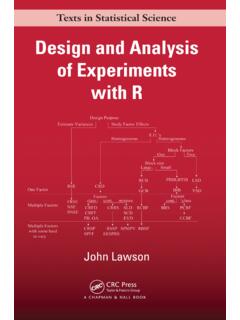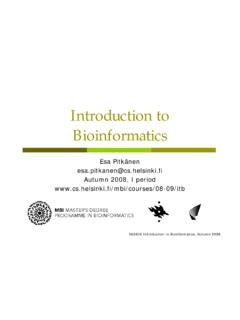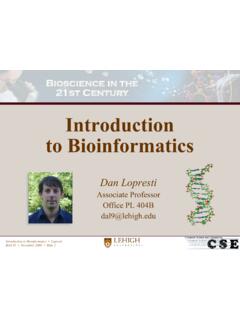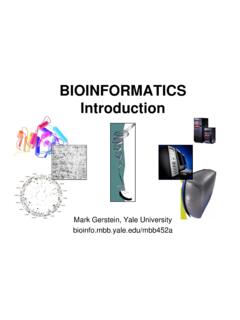Transcription of Bioinformatics: A Practical Guide to the Analysis of Genes ...
1 BIOINFORMATICSA Practical Guide to theAnalysis of Genes and ProteinsSECOND EDITIONA ndreas D. BaxevanisGenome Technology BranchNational Human Genome Research InstituteNational Institutes of HealthBethesda, MarylandUSAB. F. Francis OuelletteCentre for Molecular Medicine and TherapeuticsChildren s and Women s Health Centre of British ColumbiaUniversity of British ColumbiaVancouver, British ColumbiaCanadaA JOHN WILEY & SONS, INC., PUBLICATIONNew York Chichester Weinheim Brisbane Singapore TorontoBIOINFORMATICSSECOND EDITIONMETHODS OFBIOCHEMICAL ANALYSISV olume 43 BIOINFORMATICSA Practical Guide to theAnalysis of Genes and ProteinsSECOND EDITIONA ndreas D.
2 BaxevanisGenome Technology BranchNational Human Genome Research InstituteNational Institutes of HealthBethesda, MarylandUSAB. F. Francis OuelletteCentre for Molecular Medicine and TherapeuticsChildren s and Women s Health Centre of British ColumbiaUniversity of British ColumbiaVancouver, British ColumbiaCanadaA JOHN WILEY & SONS, INC., PUBLICATIONNew York Chichester Weinheim Brisbane Singapore TorontoDesignations used by companies to distinguish their products are often claimed as trademarks. In all instanceswhere John Wiley & Sons, Inc., is aware of a claim, the product names appear in initial capital or ALL CAPITALLETTERS. Readers, however, should contact the appropriate companies for more complete information regardingtrademarks and 2001 by John Wiley & Sons, Inc.
3 All rights part of this publication may be reproduced, stored in a retrieval system or transmitted in any form or by any means,electronic or mechanical, including uploading, downloading, printing, decompiling, recording or otherwise, except as permittedunder Sections 107 or 108 of the 1976 United States Copyright Act, without the prior written permission of the to the Publisher for permission should be addressed to the Permissions Department, John Wiley & Sons, Inc., 605 Third Avenue, New York, NY 10158-0012, (212) 850-6011, fax (212) 850-6008, E-Mail: publication is designed to provide accurate and authoritative information in regard to thesubject matter covered.
4 It is sold with the understanding that the publisher is not engaged inrendering professional services. If professional advice or other expert assistance is required, theservices of a competent professional person should be title is also available in print as ISBN 0-471-38390-2 (cloth) and ISBN 0-471-38391-0 (paper).FormoreinformationaboutWileyprod ucts, .ADB dedicates this book to his Goddaughter, Anne Terzian, for her constant kindness, goodhumor, and love and for always making me dedicates this book to his daughter, Maya. Her sheer joy and delight in the simplest ofthings lights up my world .. xiiiPreface ..xvContributors .. xvii1 bioinformatics AND THE INTERNET1 Andreas D.
5 BaxevanisInternet to the Transfer World Wide Resources for Topics Presented in Chapter NCBI DATA MODEL19 James M. Ostell, Sarah J. Wheelan, and Jonathan A. : Publications or : What s in a Name?..28 BIOSEQs: : Collections of : Annotating the : Describing the the GENBANK SEQUENCE DATABASE45 Ilene Karsch-Mizrachi and B. F. Francis and Secondary vs. Content: Computers vs. GenBank Flatfile: A Resources for Topics Presented in Chapter Example of GenBank Flatfile Example of EMBL Flatfile Example of a Record in CON DNA SEQUENCES TO THE DATABASES65 Jonathan A. Kans and B. F. Francis , Where, and What to Submit?..66 , Phylogenetic, and Mutation to Submit on the World Wide to Submit with of the Data and Genome Points for Submission of Sequence Data toDDBJ/ Resources for Topics Presented in Chapter DATABASES83 Christopher W.
6 V. HogueIntroduction to : Protein Data Bank at the Research Collaboratory forStructural bioinformatics (RCSB)..87 MMDB: Molecular Modeling Database at File Structural Structure Structure Similarity Resources for Topics Presented in Chapter MAPPING AND MAPPING DATABASES111 Peter S. White and Tara C. MatiseInterplay of Mapping and Map of and Pitfalls of Projects and Associated Uses of Mapping Resources for Topics Presented in Chapter RETRIEVAL FROM BIOLOGICALDATABASES155 Andreas D. BaxevanisIntegrated Information Retrieval: The Entrez Databases Beyond Resources for Topics Presented in Chapter ALIGNMENT AND DATABASE SEARCHING187 Gregory D.
7 Evolutionary Basis of Sequence Modular Nature of Alignment Scores and Gap Significance of Similarity Searching Scoring Resources for Topics Presented in Chapter AND Analysis OF PROTEIN MULTIPLESEQUENCE ALIGNMENTS215 Geoffrey J. is a Multiple Alignment, and Why Do It?..216 Structural Alignment or Evolutionary Alignment?..216 How to Multiply Align to Assist the Analysis of Multiple of Multiple Resources for Topics Presented in Chapter METHODS USING DNA SEQUENCES233 Andreas D. Well Do the Methods Work?..246 Strategies and Resources for Topics Presented in Chapter METHODS USING PROTEIN SEQUENCES253 Sharmila Banerjee-Basu and Andreas D.
8 BaxevanisProtein Identity Based on Properties Based on and Structure and Folding Structures or Resources for Topics Presented in Chapter SEQUENCE TAGS (ESTs)283 Tyra G. Wolfsberg and David LandsmanWhat is an EST?..284 EST Gene and Gene Human Gene Prediction in Genomic and Sequence Levels of Gene Expression Using Resources for Topics Presented in Chapter ASSEMBLY AND FINISHING METHODS303 Rodger Staden, David P. Judge, and James K. BonfieldThe Use of Base Cell Accuracy Estimates or Confidence Requirements for Assembly Readings for to Contig Contig Template Consistency Contig Contig Joining Suggestion and Resources for Topics Presented in Chapter ANALYSIS323 Fiona S.
9 L. Brinkman and Detlef D. LeipeFundamental Elements of Phylogenetic Interpretation The Importance of Identifying Paralogsand Data Analysis : The Four : Building the Data : Extraction of a Phylogenetic Data the Substitution , Parsimony, and Maximum Likelihood: What s theDifference?..345 Tree Phylogenetic Analysis Simple Practical Resources for Topics Presented in Chapter GENOME ANALYSIS359 Michael Y. Galperin and Eugene V. KooninProgress in Genome Analysis and of Comparative Genomics Reconstruction ofMetabolic Common Problems in Genome Resources for Topics Presented in Chapter for Additional GENOME ANALYSIS393 Paul S. for Large-Scale Gene Tools for Expression for the Resources for Topics Presented in Chapter PERL TO FACILITATE BIOLOGICAL ANALYSIS413 Lincoln D.
10 SteinGetting Scripts , Numbers, and Input and is Truth?.. Loops with Input and the Length of a Sequence and and Real-World to Go From Resources for Topics Presented in Chapter .. 451 Index .. 457xiiiFOREWORDI am writing these words on a watershed day in molecular biology. This morning, apaper was officially published in the journalNaturereporting an initial sequence andanalysis of the human genome. One of the fruits of the Human Genome Project, thepaper describes the broad landscape of the nearly 3 billion bases of the euchromaticportion of the human the most narrow sense, the paper was the product of a remarkable internationalcollaboration involving six countries, twenty genome centers, and more than a thou-sand scientists (myself included) to produce the information and to make it availableto the world freely and without a broader sense, though, the paper is the product of a century-long scientificprogram to understand genetic information.

















